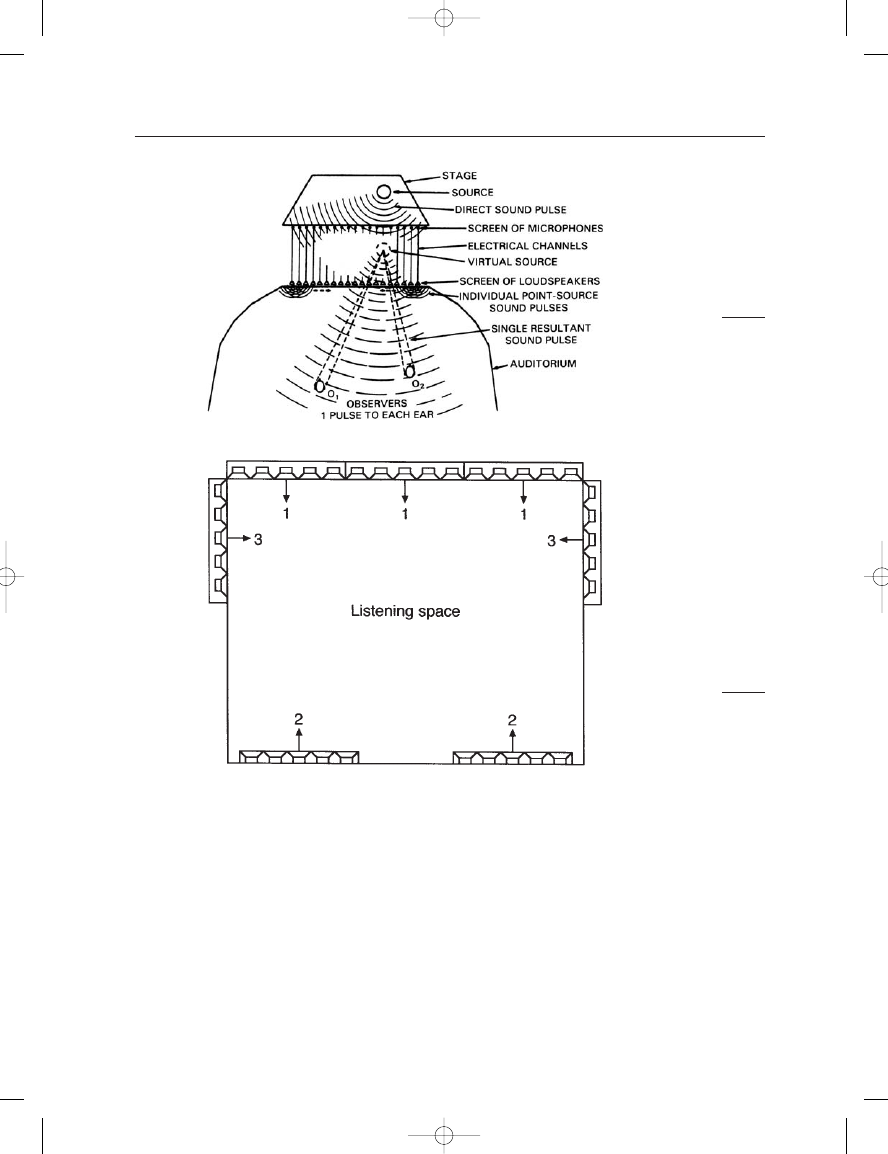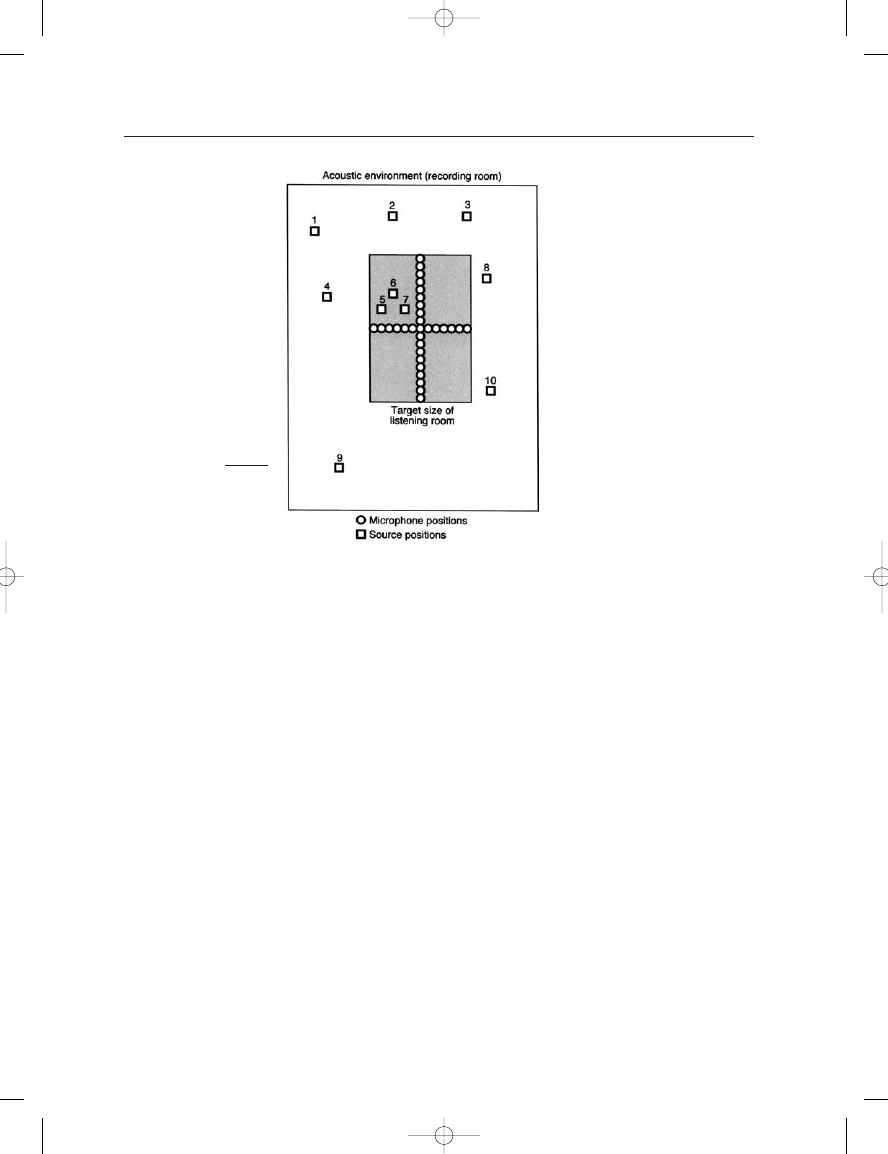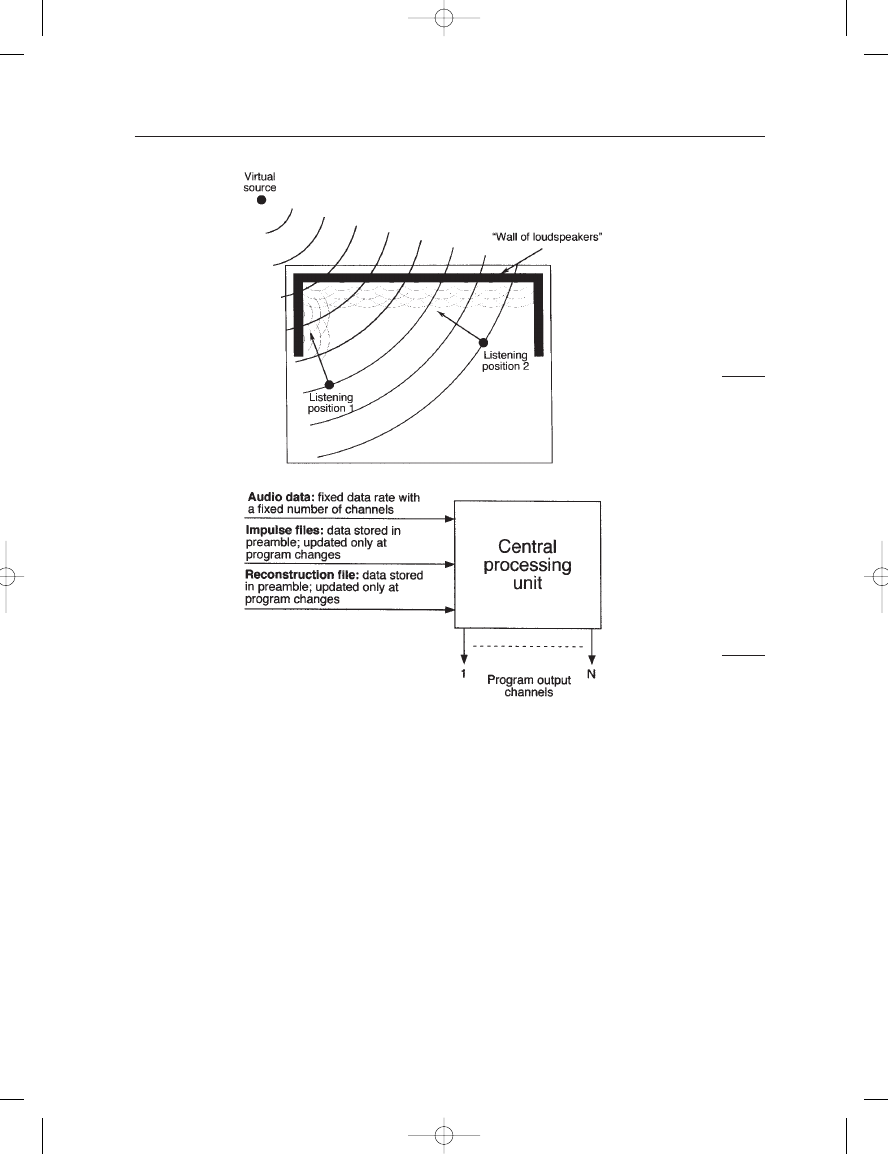ВУЗ: Казахская Национальная Академия Искусств им. Т. Жургенова
Категория: Книга
Дисциплина: Не указана
Добавлен: 03.02.2019
Просмотров: 17275
Скачиваний: 51

amplifiers, and relatively low-cost digital signal processing capability.
Horbach (2000) describes one approach to this.
A playback environment is visualized as shown in Figure 15–27.
Here, a “wraparound” loudspeaker array is placed in front and smaller
linear arrays are placed along the back wall. Ideally, we would like the
loudspeakers to be small and very closely packed; in practice, one loud-
speaker every 15 cm (6 in) is about as dense as we can reasonably get.
The data that is actually recorded consists only of the relative dry,
unreverberated instrumental tracks and other basic musical elements
produced acoustically in the studio. Details of the overall acoustics of the
recording space will have been gathered using impulse measurements,
and this added data, along with the actual music tracks, will be used to
reconstruct the recording during the playback process.
THE MICROPHONE BOOK
268
FIGURE 15–26
Snow’s multichannel
solution to motion picture
stereo. (Data courtesy of
Journal of the Society of
Motion Picture and
Television Engineer.)
FIGURE 15–27
Playback environment for
holographic sound
presentation. (Data after
Horbach, 2000.)
Earg_15.qxd 14/9/04 2:57 PM Page 268

A typical recording setup is shown in Figure 15–28. Here, a large
number of omnidirectional microphones are arranged in crossed line
arrays as shown. The small squares indicate the target locations of indi-
vidual instruments in the recording space.
The first step is to build up a large library of impulse responses. At
this stage, impulse signals are produced at each instrument location
(indicated by the numbered squares in the figure). For each studio loca-
tion, impulse measurements will be made at all of the microphone loca-
tions. If there are 10 studio locations and 31 microphone locations, there
will be 10
31, or 310 impulse response files. Each impulse file is rela-
tively small and of course needs to be made only once. Other impulse
files detailing the overall studio reverberation characteristics may be
made as well.
When the final program mix is constructed, the engineer and pro-
ducer bring together all of the individual recorded source tracks and all
of the impulse data files. A stage plan is then laid out with each instru-
ment or musical element assigned a specific position, corresponding to
one of the numbered squares in Figure 15–28. The impulse files that
define the sound stage boundaries for that signal position are then
accessed and assigned to a specific playback channel. When all of the
impulse files are convolved with the audio track and monitored over the
multi-loudspeaker playback array, the producer and engineer will hear
the audio track positioned accordingly behind the loudspeaker array.
This assignment process is repeated until all of the audio tracks have
been appropriately positioned on the virtual stage.
15: Surround Sound Microphone Technology
269
FIGURE 15–28
Recording environment for
holographic sound pickup.
(Data after Horbach,
2000.)
Earg_15.qxd 14/9/04 2:57 PM Page 269

Figure 15–29 shows how a typical virtual source is made to appear
fixed in a given location behind the loudspeaker array. Within certain
limitations, it is also possible to position virtual sources in front of the
loudspeaker array.
GENERAL COMMENTS
The methods we have just described are more akin to modern pop stu-
dio music production techniques than to verbatim recreation of natural
acoustical sound fields. While the basic data transmission rate from stu-
dio to playback is not inordinately high (and carries with it many oppor-
tunities for beneficial data reduction), the actual on-site playback data
processing rate can be quite high. As shown in Figure 15–30, only the
raw audio information is continuous; impulse data files and reconstruc-
tion information are one-time only events and can be downloaded via a
preamble to the program file. Needless to say, the playback hardware
must be efficiently designed to handle all of this on a timely basis.
THE MICROPHONE BOOK
270
FIGURE 15–29
Playback of a virtual
source and the directions
perceived at two listening
positions. (Data after
Horbach, 2000.)
FIGURE 15–30
Overview of signal flow in
a system with parallax.
Earg_15.qxd 14/9/04 2:57 PM Page 270

C
H
A
P
T
E
R
1
6
SURROUND RECORDING
CASE STUDIES
INTRODUCTION
In this section we will examine six surround recordings that demonstrate
a number of the techniques discussed in the previous chapter. These
examples range from fairly modest studio resources up to large concerted
works that include chorus, organ, piano, and percussion ensembles in
performance with normal orchestral resources. In each case, recording
channel limitations restricted us to no more than eight tracks. This called
for careful planning, since the eight “stems” had to be used not only for
creating surround mixes but also for making any adjustments in the stereo
mix during later postproduction. In this connection we will introduce a
concept of subtractive mixing, as it applies to demixing and subsequent
remixing, of tracks to attain an ideal balance.
All of the projects studied here were targeted for both stereo and
standard 5.1 channel playback. In each case we will present the basic
microphone choice and layout, channel assignments, mixing assignments
in both stereo and surround, and an overall commentary. All of the proj-
ects discussed here have been commercially released, and a discography
is included at the end of this chapter.
The items to be discussed are:
1. Berlioz: March to the Scaffold from Symphonie Fantastique
(orchestra)
2. Tchaikowsky: 1812 Overture (orchestra with chorus)
3. Gershwin: Rhapsody in Blue (orchestra and piano)
4. Berlioz: Te Deum (orchestra with chorus, vocal soloist, and organ)
5. Bizet-Shchedrin: Carmen Ballet (strings and large percussion
ensemble)
6. Schnittke: Piano Concerto (strings and piano)
Earg_16.qxd 14/9/04 2:58 PM Page 271

A SURROUND MIXING RATIONALE:
DEFINING THE SOUND STAGE
What is the purpose of a surround sound musical presentation? One
answer, especially for classical music, is to present that music in the con-
text of the original performance venue with its acoustics intact. For pop
and rock music another goal may be to place the listener in the center of
an imaginary stage, with sound elements widely positioned all around.
Both are respectable goals, and there should be no prejudice favoring one
over the other.
The recordings described here all fit neatly into the former, or so-called
direct-ambient, approach in which there is a stage at the front and an
enveloping ambience, based on the peformance space, that reaches the
listener from all directions. This does not happen casually, and there are
some general procedures that should be followed. They are:
1. Controlled monitoring environment: An ITU standard loudspeaker
monitoring array was used with reference levels set to within 0.25 dB.
Even though the mix was made with engineer and producer sitting
at the “sweet spot,” the program was auditioned at various points
within the periphery of the loudspeakers to ensure that it was
generally and broadly effective.
2. Decorrelated ambience: The basic ambient signature of the perform-
ance space is presented over all loudspeakers except the front center,
and these four ambience signals are all decorrelated, either through
signal processing or through the original spacing of microphones.
3. Control of early reflections: In any performance venue, early reflec-
tions arising primarily from side walls help to define the boundaries
of the space and convey a sense of room size. If the reflections are
too early and too high in level, they may add muddiness and
confusion. The optimum delay range for them is between 25 and
40 milliseconds, presented at a level between
10 and 15 dB
relative to the primary signal. If we’re lucky, these signal compo-
nents are produced directly in the room and are picked up natu-
rally; at other times, the engineer has to create them via signal
processing using modern delay and reverberation generators. These
signals are normally introduced into the mix only in the left and
right-front channels as well as the two rear channels. In some cases
it is effective to delay the rear signals slightly, relative to the front
left and right signals. You will see application of these techniques
as we progress through this chapter.
4. Layers: When multiple microphones have been used in a recording –
and this is the norm today – it is often helpful to think in terms of
structural layers in the recording. For example, the main frontal
microphones (and soloist microphones if appropriate) comprise a
single layer. The ensemble of accent, or spot, microphones in the
THE MICROPHONE BOOK
272
Earg_16.qxd 14/9/04 2:58 PM Page 272